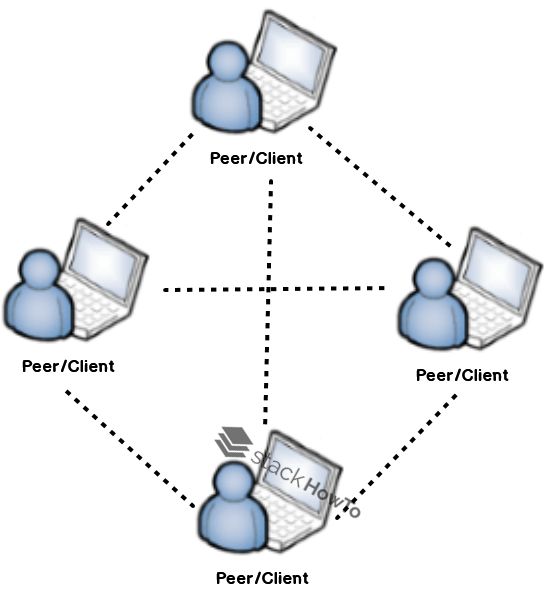Peer-to-peer Architecture Advantages and Disadvantages with example
In this tutorial, we are going to see the Peer-to-peer architecture advantages and disadvantages with example. In a peer-to-peer (P2P) architecture, unlike a client/server network architecture, there is no dedicated server. Thus, each computer in such a network plays the role of both server and client. This means that each computer in the network is free to share its resources. A computer connected to a printer may share it so that all other computers can access it via the network.

Disadvantages of Peer-to-peer Networks
However, peer-to-peer networks have a number of disadvantages:
- The system is not centralized at all, which makes it very difficult to manage;
- Security is less easy to ensure, due to the transversal exchanges;
- No link in the system can be considered reliable.
Thus, peer-to-peer network architecture is preferentially used for applications that do not require a high level of security or maximum availability (it is therefore not recommended for a professional network with sensitive data).
Advantages of the Peer-to-peer Architecture
Peer-to-peer architecture has the following advantages
- low cost (the only costs involved in such a network are hardware, cables, and maintenance)
- simplicity at all costs!
Implementing a Peer-to-peer Architecture
Peer-to-peer networks do not require the same levels of performance and security as dedicated server networking. One can therefore use Windows NT Workstation, Windows for Workgroups or Windows 10 because all these operating systems integrate all the features of a peer-to-peer network.
The implementation of such a network architecture is based on standard solutions:
- Place the computers on the users’ desktop
- Each user is his own administrator and plans his own security
- For the connections, a simple and visible cabling system is used
This is generally a good solution for the following environments:
- Less than 10 users
- All users are located in the same geographical area
- Security is not a critical issue
- Neither the company nor the network is likely to change significantly in the near future
Managing a peer-to-peer network
The peer-to-peer network meets the needs of a small business but may not be appropriate in some environments. Here are the issues to be addressed before choosing the type of network: The term “Administration” refers to:
- User and security management
- Resource provisioning
- Application and data maintenance
- Installing and upgrading user software
In a typical peer-to-peer network, there is no administrator. Each user administers his or her own workstation. On the other hand, all users can share their resources as they wish (data in shared directories, printers, fax cards etc.)
Basics of security
The minimum security policy is to put a password on a resource. Users on a peer-to-peer network define their own security and since all shares can exist on all computers, it is difficult to implement centralized control. This also poses a problem for overall network security because some users do not secure their resources at all.



